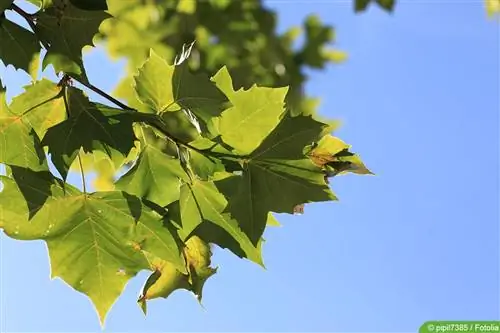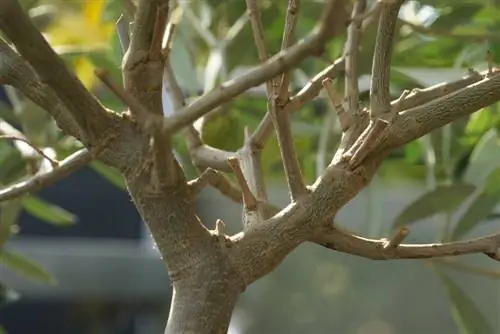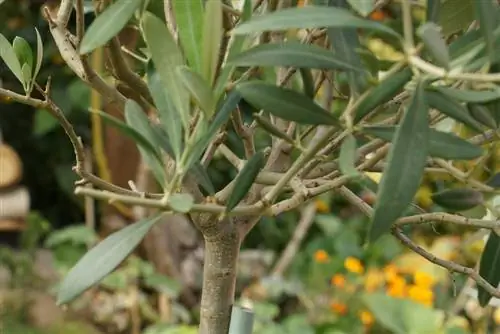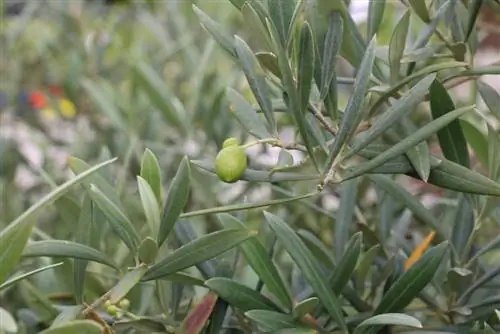- Author admin [email protected].
- Public 2023-12-17 03:39.
- Last modified 2025-01-24 12:45.
The olive tree, also known as the real olive tree, grows in its natural habitat as an evergreen, well-branched tree or shrub and can live for several hundred years. As it gets older, it impresses with bony, deeply furrowed trunks, which of course is not so noticeable in the pot. Here they remain much smaller, but that doesn't detract from their attractiveness. Olive trees are sold commercially as standard trees or as bushes. Both versions conjure up a Mediterranean flair on the terrace, balcony or in the winter garden.
Location
Everywhere in Germany where very cold frost nights are to be expected, it is advisable to keep olive trees exclusively in pots. These attractive and sun-hungry plants want to be sunny all year round if possible. Keeping them outdoors all year round is not possible due to the limited frost hardiness. However, short-term temperatures of up to minus 5 degrees are tolerated without damage.
Depending on the weather, from around the end of March/beginning of April to autumn, the olive can be placed outdoors in a wind-protected and draft-free place with constant sun. If one side of the plant gets more and longer sun than others, it is advisable to rotate it every now and then so that it grows more regularly. If olive trees are left outside for as long as possible, it makes overwintering easier because they are then much more robust and resilient.
Floor
Olives are relatively undemanding when it comes to soil conditions. You should just make sure that the substrate is not too moist. Loose, permeable, sandy and not too nutrient-rich soils are recommended. You can mix it yourself from two thirds of commercially available potting soil and at least one third of gravel, lava rock or coarse sand, but you can also use special citrus soil or high-quality potting soil.
Care
These plants are a common sight in their country of origin, where you can admire specimens that are sometimes thousands of years old. In this country too, they prefer to be kept outdoors if possible and are completely unsuitable for keeping them indoors. While young olive trees still require a little more care, this becomes more limited as they get older. They are far from forgiving of every care mistake, which is why you should follow a few basic rules.
Pouring
The olive tree should be watered neither too much nor too little, but should still be watered regularly. It requires a lot of water, especially in summer. Young plants and freshly planted specimens should also be watered a little more in the first two years of life. This applies even more to plants grown in containers, because the substrate dries out more quickly. Basically, you need to water more in warm, dry and windy weather than in cool and damp weather.
- Water enough to moisten the substrate down to the bottom of the pot
- Before each watering, allow the substrate to dry thoroughly on the surface
- Adjust watering frequency and amounts to natural rainfall
- Occasionally spray additionally with water
- Waterlogging is the biggest problem with these plants
- It can lead to root rot and death of the tree
- Dryness should not last longer than a few days
Tip:
To protect against waterlogging, make sure there is a drainage layer of around 10 cm thick and avoid planters and saucers, as they can accumulate irrigation water there.
Fertilize
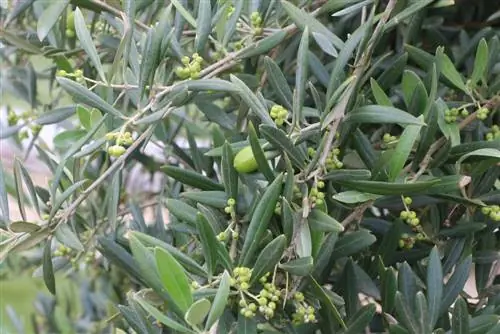
To cover their nutrient requirements, potted plants must be supplied with fertilizer once a week during the growing season, approximately from April to September. Special fertilizers for citrus plants are suitable because the nutrient requirements of citrus plants are very similar to those of olive trees. Of course, other high-quality fertilizers can also be used for potted plants.
Wintering
Proper wintering can be crucial for the preservation and thriving of these magnificent plants for many years. If they still bloom and produce fruit, you've done everything right. The first step is to find suitable winter quarters. This should be bright and cool, with temperatures between 5 and 10 degrees. Unheated but frost-free greenhouses, winter gardens and adjoining rooms have proven successful. Heated living spaces are completely unsuitable for overwintering an olive tree. Here it is too warm, too dark and the air is much too dry.
So-called wintering tents are available in stores, which, in conjunction with a frost monitor, may be suitable for overwintering on the balcony. Here the bucket should be protected from freezing. With such tents, it is essential to ensure appropriate ventilation. If there is insufficient ventilation, leaf loss and rot are inevitable.
Basically, these plants should stay outdoors as long as possible and not be brought indoors too early. If the temperatures in the winter quarters are below 12 degrees, the olive tree reduces its metabolism so that it can cope with slightly less light. At temperatures around 5 degrees, the plant falls into a kind of hibernation. Even now, the substrate should not dry out completely and should be watered sparingly from time to time. Too much moisture must be avoided at all costs, especially during wintering. There is no fertilization in winter.
Repotting before putting out
The better the wintering, the easier it is to move from winter quarters to the outdoors. When an olive tree thrives, the roots also grow and thrive, so the pot soon becomes too cramped for them. In addition, the substrate will eventually be exhausted, so it's time to repot into fresh soil.
- Once the desired final size is reached, the same pot can be used again
- If you want the olive tree to continue to grow, the new pot should be a little larger
- About 4 cm more in diameter is sufficient
- Pot must have sufficient drainage holes
- Material of the planter does not matter
- Fill the pot a third full with coarse gravel or gravel
- Then the substrate, which is also mixed with drainage material
- This ensures the best possible permeability and ventilation
- Then take the plant out of the old pot
- Check the roots for possible damage
- Remove dead and rotten areas on the root ball
- The best way to do this is to lay the tree down
For plants that are put back in the old pot, shorten the roots by about 2 cm. If you use a larger pot, plant the plant as usual and fill it all around with fresh soil. Then press them firmly and water generously and thoroughly. There is no need to fertilize in the following 6 weeks.
Tip:
After watering immediately after transplanting, you can avoid watering again in the next few weeks. At this time of year it is still quite cool, so the olive tree only evaporates a little water.
Cut after wintering
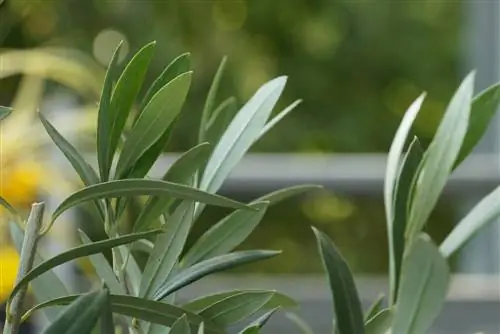
In addition to repotting, pruning is one of the first care measures in early spring. Anyone who wants to have a beautifully grown, he althy olive tree that perhaps even flowers and produces fruit cannot avoid regular pruning. These ensure that the plants get or maintain a beautiful shape and ensure optimal ventilation inside the crown.
If you stick to a few basic rules, it's not as difficult as many people fear. Only sufficiently sharp cutting tools should be used for cutting to avoid crushing and tearing of the interfaces. Disinfecting the tools also makes sense; this can prevent the transmission of pathogens. Now you can get started with the so-called maintenance cut.
Conservation cut
The maintenance cut is relatively unspectacular. It is primarily used to remove or correct minor damage and blemishes. A maintenance cut can be carried out immediately after overwintering from the end of February to the beginning of March. Maintenance pruning measures can also be carried out later in spring or summer. Start with the crown and cut out all dead and diseased branches and, if necessary, entire branches. In addition, regrowing shoots on the trunk can be removed. Under no circumstances should it be cut back too much, because then new growth is not guaranteed.
Tip:
You can tell whether a twig or branch has died by looking at the channels that are located directly under the bark. You remove a small piece of bark, starting at the tip of the crown. If it is freshly green underneath, the twig or branch is still alive. On the other hand, a brownish color indicates that it is already dead and can be removed. In order not to treat the plant unnecessarily, you should only remove bark from areas where there is a suspicion that this area has died.
Educational Cut
The training cut should be carefully considered, because incorrectly removed twigs or branches leave gaps for many years that the plant can hardly make up for. The aim of the training pruning is to build up the crown structure with leading and secondary branches, to shape the crown and to make corrections inside the crown.
- Cut out the weaker ones from crossing shoots inside the crown
- Short shoots that protrude from the crown so that the external shape is retained
- For renovation or to build up the crown, remove larger side branches if necessary
- Optimal crown consists of a strong, central main shoot and several secondary shoots
- Competitive instincts are not desirable and should be cut out
- This allows enough light and air to reach the inside of the crown again
Tip:
Even if these plants are relatively easy to cut, they should always be cut cautiously, because less is definitely more here. If you cut away too much or in an unfavorable place, it can sometimes take a long time until this gap can be filled again. He althy olive trees in particular should not be cut back radically.
When to go outside?
Basically, the duration of overwintering should be as short as possible and the olive tree should be returned outdoors as early as possible. The decisive factors are the prevailing and expected temperatures in the respective region, especially at night and in the early morning hours. Longer-term weather forecasts from German weather services can be of little help. However, you shouldn't rely solely on it. As a rule, the plants can be removed as soon as the temperatures are consistently above minus 5 degrees. In the first few days you should choose a location without direct sunlight to avoid burning the leaves.
Propagate
Sowing
Olives sold in stores are usually prepared and therefore not suitable for sowing. If you have an olive tree that has ideally borne fruit, then fresh seeds are no problem. Corresponding seeds are also available from specialist retailers. Neither the fruits nor the seeds should show any damage. It's best to always sow several seeds, because not all of them are capable of germinating.
- First remove the pulp from the stones of fresh olives
- Wash off smaller residues under running water
- First soak commercial seeds in lukewarm water for about 24 hours
- Change the water several times during this process
- Then carefully score or file seeds to accelerate germination
- Place the seeds with the tip upwards in germ-free potting soil
- Planting soil should be loose, permeable and low in nutrients
- Cover the cores with a maximum of half a centimeter of soil
- Substrate then moisten and keep moist
- Place the cultivation container in a bright and warm place without direct sunlight
At temperatures of at least 20 - 25 degrees and depending on the soil temperature, it can take between 4 and 12 weeks for germination. As soon as the small seedlings are visible, they need a lot of light, otherwise they would shoot up too quickly and die. A sheltered and bright place in the garden is best now, initially without direct sunlight. After another two months, some liquid fertilizer can be administered.
Tip:
An olive tree grown from seeds can be classified as wild olives, which only produce very small fruits and only after about 10 years at the earliest. However, there is the possibility of using exactly these plants, if they are a little older, as a so-called rootstock for a noble olive, provided you can get the appropriate cuttings.
Cuttings
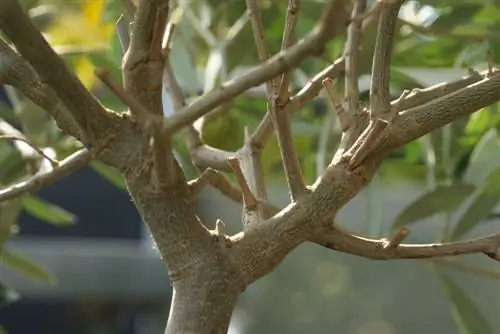
Prohibition using cuttings is somewhat more promising than sowing. The substrate used for this should also be germ-free. From an existing plant, you cut several young, non-woody shoots about 5-10 cm long, each of which should have at least three eyes. The cut should be made at an angle, which makes it easier for the cutting to absorb water.
The lower leaves are removed and the cuttings are placed in small pots with potting soil. The earth is pressed all around and moistened. Then place the whole thing in a bright and warm place at temperatures between 20 and 30 degrees. Use a spray bottle to keep the substrate evenly moist. If the first shoots appear after a few weeks, the propagation has been successful and the cuttings can be cultivated accordingly.
Pests and diseases
Spider mites
Infestation with spider mites occurs primarily under unfavorable conditions during overwintering. It can be recognized, among other things, by fine white webs, preferably on the undersides of the leaves. If an infestation is discovered, it can be combated by spraying with a decoction made from the seeds of the neem tree or nettles, which can also strengthen the plants.
Root rot
Root rot is usually the result of too much moisture. The leaves wilt, fall off and, in the worst case, the olive tree dies. If it is detected early, the best thing you can do is save the plants by repotting them immediately. In the future, however, you should make sure to water as needed.
Leaf shedding
If the olive tree loses leaves, this is usually due to unfavorable wintering conditions. This can be a lack of light, overwintering that is too warm or too cold, and too much or too little water. To counteract this, optimal conditions should be ensured. In addition, you should pay attention to high-quality plants when purchasing. For example, the crown, trunk and roots should not show any damage or cuts. Growths on the trunk and branches or spots on the leaves can indicate disease or fungal infection. You should definitely avoid buying such plants.
Conclusion
In Mediterranean gardens, the olive tree is the star. Its care is comparatively demanding and it only forgives a few care mistakes. Nevertheless, he finds more and more lovers. Under optimal conditions, even a small olive tree in a pot can grow very old. It is a symbol of peace, love and stability, making it the perfect gift for special people.


